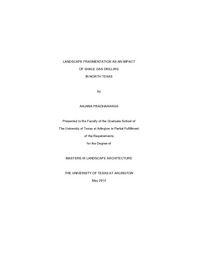| dc.description.abstract | The objective of this study is to determine the degree to which shale gas drilling contributes to the fragmentation of landscapes in North Texas, especially in prairies. The study is conducted on the Barnett Shale area where shale gas exploration began in the 1980's (Arthur et al. 2008). The Barnett Shale area lies under much of the developed regions of the Dallas-Fort Worth metropolitan area as well as beneath an extensive amount of rural countryside mainly used for private recreational lands, exurban residential development, suburbs, and improved pasture and ranching. However, most of the drilling is occurring in the Grand Prairie and Plains ecoregion, where the dominant land cover is prairie. This research is aimed at producing data and information for local, regional, and state policy-makers engaged in activities related to surface drilling.More specifically, findings from this study are expected to be useful for understanding and foreseeing the long term ecological impacts of surface drilling on prairies in North Texas and for identifying ways to ameliorate these potential adverse impacts. Findings from this study are expected to influence the setting of priorities that can reduce the adverse impacts of surface drilling on landscapes. In order to quantify fragmentation, analyses of three sample sites are carried out in this study. Each sample site differs from another in terms of the intensity of shale gas drilling within the sample site area. This means each sample site has a different number of well pads though the size of the three sample sites is the same.To conduct this quantitative study, longitudinal land cover data for the three sample sites are collected. Well pad data, impoundment area data, and road data are then prepared using the Geographic Information System (GIS). These data are then analyzed using the Landscape Fragmentation Tool (LFT), which maps fragmentation for any type of land cover, for example, grassland, and categorizes the land cover type into patch, edge, perforated, small core, medium core, and large core. LFT is a python script that runs in ArcGIS (Vogt et al. 2007).The study concludes that patch, edge, and small core landscape conditions increase as a result of shale gas drilling. Patch conditions are mostly observed where roads crisscross. With more intense drilling activity, edge conditions form the dominant landscape conditions. With less intense drilling activity, perforated conditions are dominant, signifying the early stage of fragmentation. On the other hand, medium core and large core conditions decrease with the increase in the drilling activity.Outcomes for this study include the identification of components of shale gas drilling that are responsible for landscape fragmentation. Additionally, the research identifies procedures and steps that landscape architects, planners, and policy makers can follow to lessen future surface impacts from shale gas drilling. | en_US |

